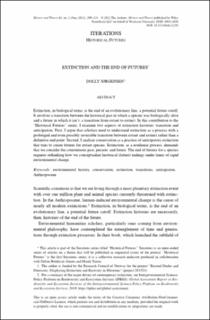| dc.contributor.author | Jørgensen, Dolly | |
| dc.date.accessioned | 2022-09-01T12:20:50Z | |
| dc.date.available | 2022-09-01T12:20:50Z | |
| dc.date.created | 2022-08-26T11:04:47Z | |
| dc.date.issued | 2022-06 | |
| dc.identifier.citation | Jørgensen, D. (2022) Wiley Periodicals LLC on behalf of Wesleyan University. History and Theory, 61 (2), 209-218. | en_US |
| dc.identifier.issn | 0018-2656 | |
| dc.identifier.uri | https://hdl.handle.net/11250/3015164 | |
| dc.description.abstract | Extinction, in biological terms, is the end of an evolutionary line, a potential future cutoff.It involves a transition between the historical past in which a species was biologically alive and a future in which it isn’t, a transition from extant to extinct. In this contribution to the “Historical Futures” series, I examine two aspects of extinction histories: transition and anticipation. First, I argue that scholars need to understand extinction as a process with a prolonged and even possibly reversible transition between extant and extinct rather than a definitive end point. Second, I analyze conservation as a practice of anticipatory extinction that tries to create futures for extant species. Extinction, as a nonlinear process, demands that we consider the coterminous past, present, and future. The end of futures for a species requires rethinking how we conceptualize historical (future) endings under times of rapid environmental change. | en_US |
| dc.language.iso | eng | en_US |
| dc.publisher | Wiley Periodicals LLC on behalf of Wesleyan University | en_US |
| dc.relation.uri | https://onlinelibrary.wiley.com/doi/epdf/10.1111/hith.12258 | |
| dc.rights | Attribution-NonCommercial-NoDerivatives 4.0 Internasjonal | * |
| dc.rights.uri | http://creativecommons.org/licenses/by-nc-nd/4.0/deed.no | * |
| dc.subject | utryddelse | en_US |
| dc.subject | miljøhistorie | en_US |
| dc.title | Extinction and the End of Futures | en_US |
| dc.type | Peer reviewed | en_US |
| dc.type | Journal article | en_US |
| dc.description.version | publishedVersion | en_US |
| dc.rights.holder | © 2022 The Authors. | en_US |
| dc.subject.nsi | VDP::Humaniora: 000::Historie: 070 | en_US |
| dc.source.pagenumber | 209-218 | en_US |
| dc.source.volume | 61 | en_US |
| dc.source.journal | History and Theory | en_US |
| dc.source.issue | 2 | en_US |
| dc.identifier.doi | 10.1111/hith.12258 | |
| dc.identifier.cristin | 2046258 | |
| dc.relation.project | Universitetet i Stavanger: IN-11621 | en_US |
| dc.relation.project | Norges forskningsråd: 283523 | en_US |
| cristin.ispublished | true | |
| cristin.fulltext | original | |
| cristin.qualitycode | 2 | |

